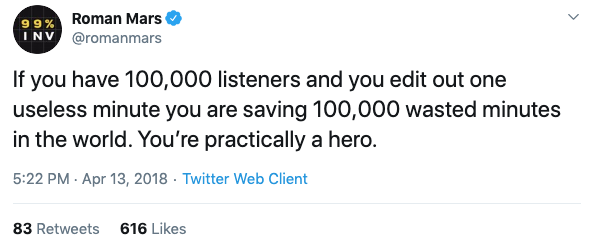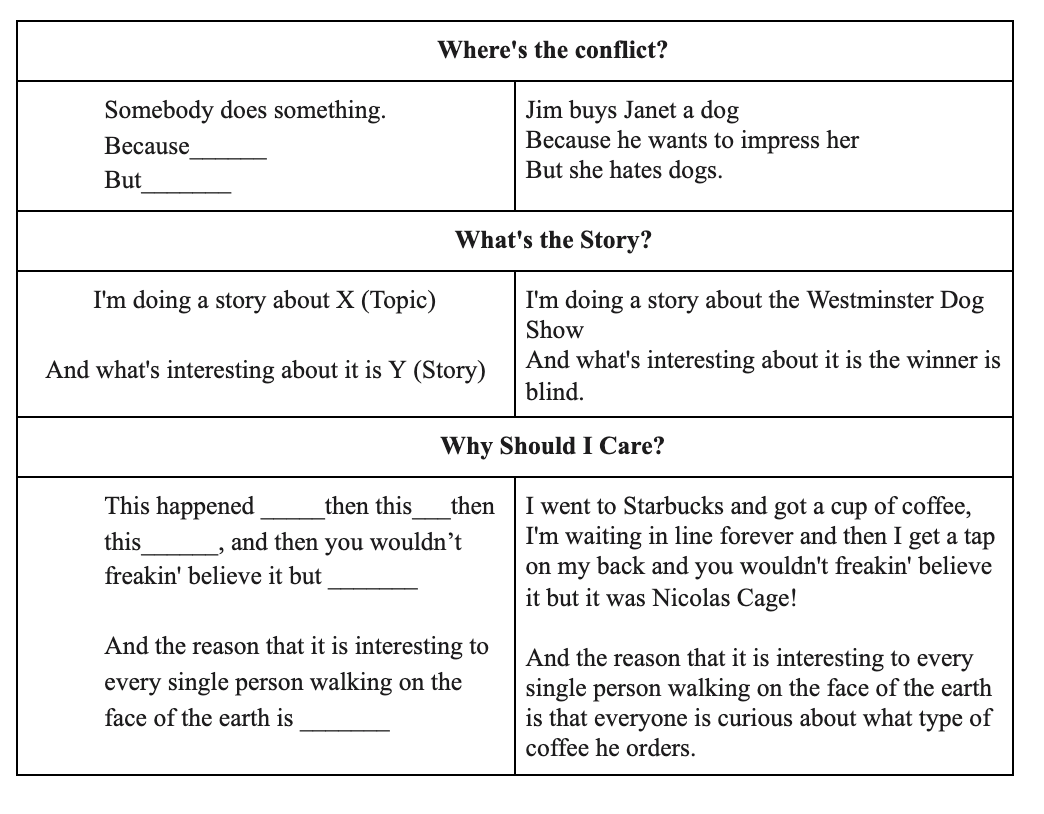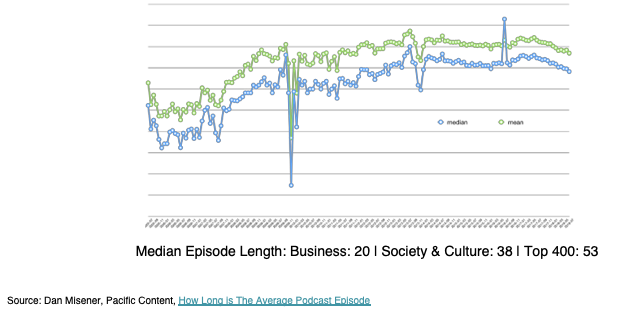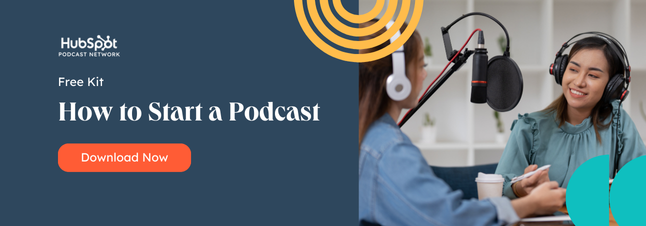Over the past few years, podcasts have undeniably risen in popularity. In fact, almost a quarter of all Americans listen to a podcast each week — for reference, that’s nearly four times the amount of people who watched the Game of Thrones final season premiere.
But, ultimately, what makes a good podcast episode?
Why do some episodes leave a lasting impact on us, while others fall flat?
There’s no science to creating the perfect podcast episode, but we can still dissect the decisions producers make that result in a memorable podcast.
As HubSpot’s Senior Marketing Manager of Podcasts, as well as host of HubSpot’s podcast Weird Work, I’m undeniably familiar with the trials and tribulations of creating a good episode, and a good series.
Here, I’m going to share with you what I’ve learned about the anatomy of a perfect podcast episode, so you can create a successful, impactful podcast for your own brand.
To Edit … or Not to Edit
Many incredibly successful podcasters have mastered the art of unscripted and unedited interviews — but far more people have tried and failed miserably.
While unedited podcasts can sound authentic and personal, they can also sound like long-winded freewheeling conversations that go nowhere.
A good, unedited podcast minimizes dead air by seamlessly moving from one topic to another and keeping the conversation lively over an extended period of time.
It’s important to note — if you’re not going to edit your podcast episodes, the host needs to do an enormous amount of research on each guest or topic to ensure they aren’t scrambling for what to say next.
During really successful unedited interviews, the host will often reference articles the guests have written, critical responses to guest views, or personal stories.
For a masterclass in interview-prep, check out this interview with actor Shia LaBeouf on the YouTube series Hot Ones. The host has clearly done an enormous amount of research, which enables him to pull all the most interesting tidbits out of LaBeouf.
A good, unscripted podcast is rarely a host simply asking a guest to explain something to them.
However, here at HubSpot, we lean towards editing. Editing allows us to shape the conversations to be more impactful without significantly altering the content of the conversation. Editing is being kind to your listener.
As Roman Mars, creator of 99% Invisible, says, “If you have 100,000 listeners and you edit out one useless minute, you are saving 100,000 wasted minutes in the world. You’re practically a hero.”

Hook ‘Em
The first few minutes of a podcast is the most important part of an episode. It lets listeners know what the episode is going to be about, and piques their interest.
There are many people who use the introduction to do absolutely nothing useful for the listener. Listing what episode number it is or doing general housekeeping only detracts from your goal of getting the listener interested in the rest of the episode.
One of the most powerful introductions I’ve heard recently is from 1619: How The Bad Blood Started. The episode starts out with a heart-wrenching story of how one woman’s uncle got sick and refused to get treatment. He ended up getting treatment, but ultimately received it a little too late. The episode is more broadly about healthcare for African Americans after the Civil War, and how it impacts healthcare today.
Ultimately, your introduction doesn’t need to have anything to do with your episode, as long as it hooks the listener.
For example, one of my favorite podcasts, Heavyweight, starts each episode with its host Jonathan Goldstein calling his best friend Jackie and inevitably getting hung up on because of something he says. It’s a very light, fun way to open each episode and it’s something I look forward to as a listener.
A Good Podcast Episode is Focused!
When you’re thinking about creating an episode, you want to be able to easily articulate what the episode is about. This sounds simple, but it’s easier said than done.
Many episodes are about “lots of things” and touch on “many different themes”. This is all well and good, but producers still need to succinctly explain what the story is about.
The book Out on the Wire: Story Secrets From the New Masters of Radio offers an excellent explanation of “focus sentences”. These are Mad Libs style fill-in-the-blanks that you should filter your episode content through to see if you have a good story.
Here are three example focus sentences:

Once you have a focus for your episodes, the next step is ensuring you have the right pieces in place.
Let’s explore those pieces, now.
The Pieces of a Good Episode
Hats off to Alli Torban, a podcaster and data analyst who evaluated the top two podcasts for every category in iTunes to identify the patterns of a successful episode.
One of Torban’s findings was this: good podcast episodes are a mix of educational, entertaining, and inspirational content that is arranged in a different way for each episode.

Image Source
On my show Weird Work, an interview podcast in which we talk with people who have unusual occupations, all episodes contain three pieces:
- Nuts & Bolts (educational) where we explain the in’s and out’s of someone’s unusual occupation.
- Personal story (entertaining) where we talk about how someone got into the bizarre field they are in.
- Big idea (inspiration), this is where we discuss an overarching concept behind their work (like discussing the appeal of knighthood in the modern era with the head knight of Medieval Times).
The order of these pieces varies from episode to episode. Some episodes open with the big idea hooking the listener, or an interesting concept to consider. Other episodes may follow a more linear path by talking about the guest’s personal story, the work they are in now, and the implications of that work on a larger scale.
There is no award-winning pattern for how to arrange your content. How you structure your episode is going to depend on the story you want to tell. Laura Walker, former head of WNYC studios, said it best at the Podcast Movement conference in Orlando when she said — “Podcasts need to motivate you to think differently.”
If your episode is arranged in a way that motivates a shift in the way your listener sees the world, it will be a success.
All the Garnish, Please
If making a podcast episode is like cooking a meal, then sound design and music are the toppings and garnish that makes all the difference.
Let’s start with the basics — like, What is sound design? Sound design is anything you are doing to manipulate the way your content sounds. Sound design in podcasting can be any sort of music that plays while someone is talking.
Sound design can also be an alteration to the way people are speaking to help set the scene.
Just think how dull a horror movie would be without those ominous tones.
If you’re interested in exploring the importance of sound design, take a listen to the podcast Twenty Thousand Hertz. The show is all about the world’s most iconic sounds, produced by sound design studio Defacto Sounds. It’s truly incredible insight into the world of sound and the impact it has on our lives.
How Long Should Your Episode Be?
There is no ideal length for a podcast episode. It all depends on the content you’re creating and the type of show you’re producing.
In this incredibly in-depth analysis by Dan Mier of Pacific Content, he analyzed the average length of episodes over time:

Image Source
This analysis provides some interesting insights — for instance, it demonstrates the average podcast is actually quite long, compared to other forms of media. Business podcasts tend to be shorter than several other podcasts, but there is nothing to indicate that shorter podcasts are destined to be more successful.
However, it’s still important to note — listeners can get bored easily. While there is no set number that is ideal for the length of a specific episode, try to make something that does not drag or waste listeners’ time.
At HubSpot, we try to keep ourselves within a general range of 20 to 40 minutes per episode for The Growth Show and Weird Work. Additionally, in our new season of Skill Up, we are going to be experimenting with much shorter episodes, around 10 minutes.
Ultimately, podcasts are still evolving. What worked yesterday may not work as well today, and what never caught on a few years ago may be the next big thing.
At the end of the day, you shouldn’t feel trapped by a format or set of guidelines. Instead, you should think about the unique story you want to tell and your unique angle on that story. The content should entertain, educate, and inspire in a reasonable amount of time.
Just remember — the perfect podcast episode will make your listener think differently about a topic. However that happens is up to you.

